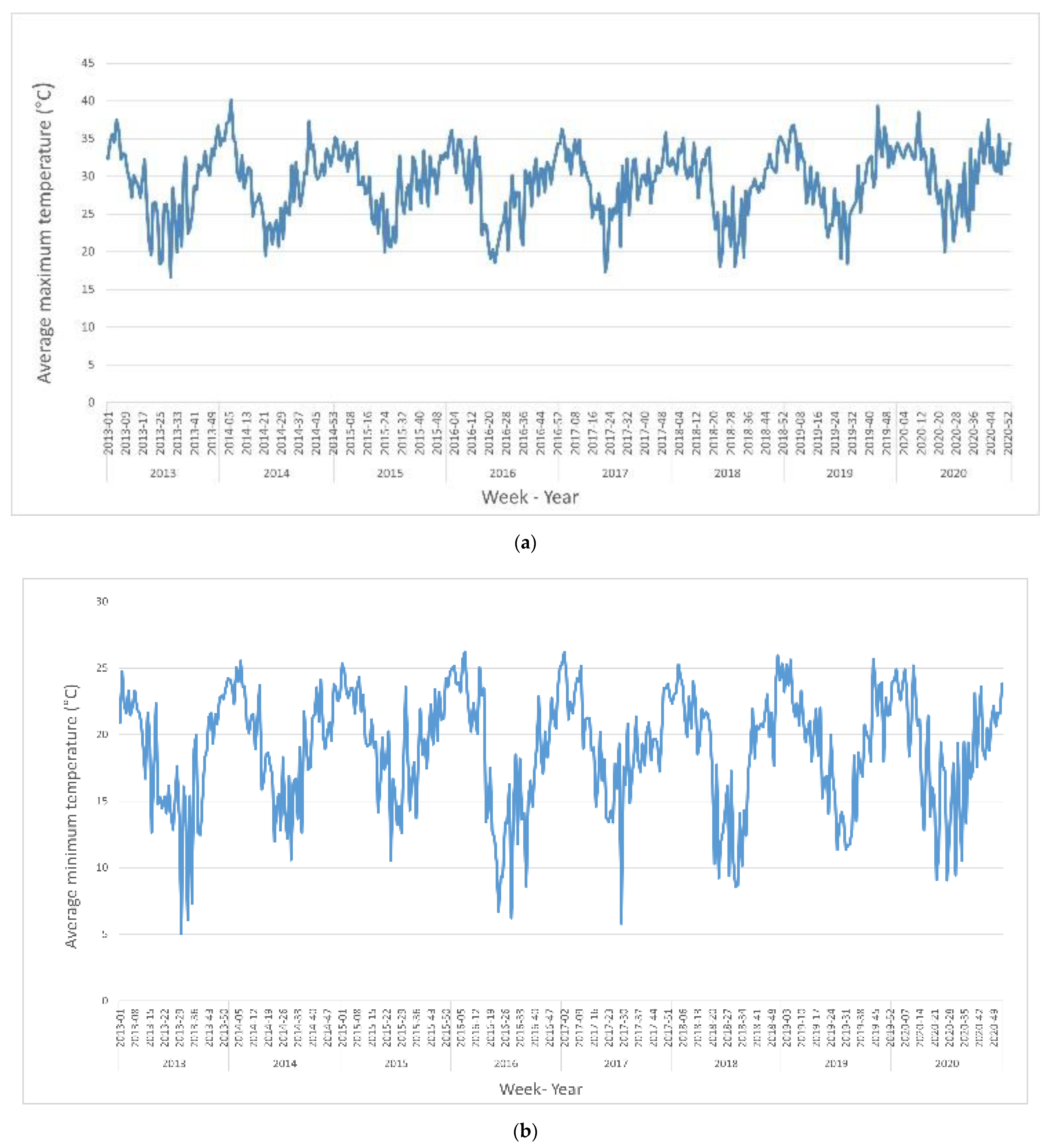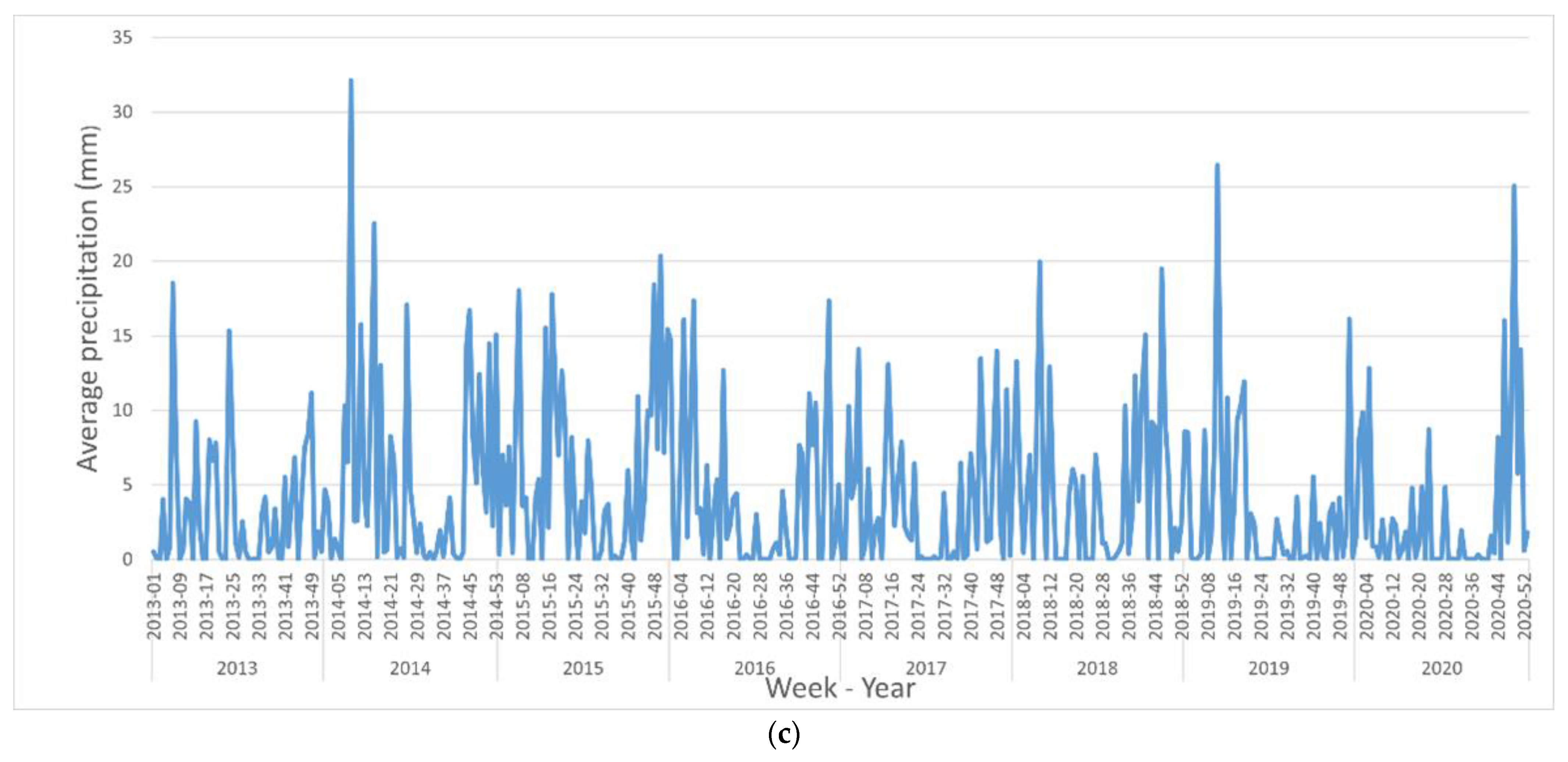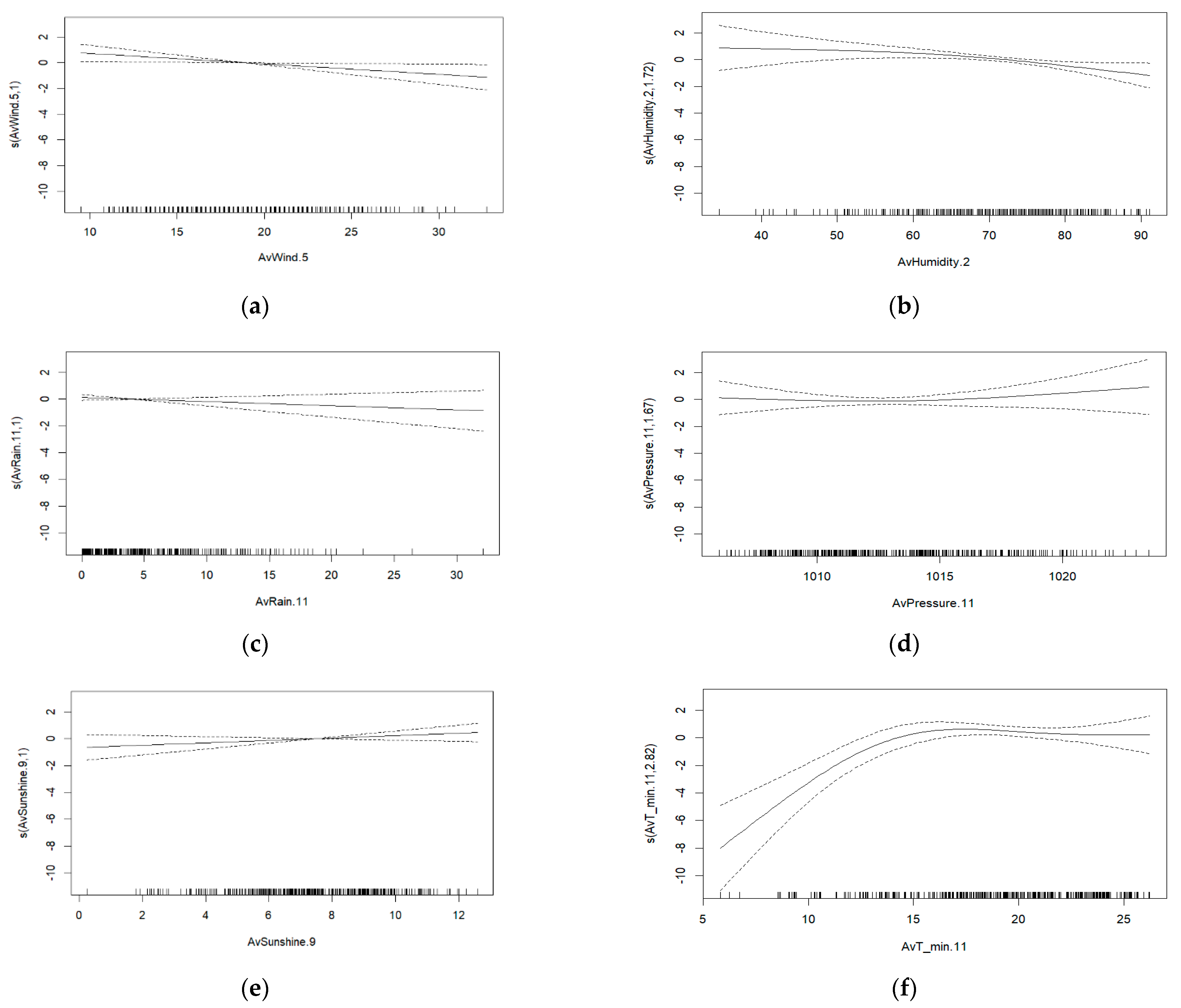Association between Climate Factors and Dengue Fever in Asuncion, Paraguay: A Generalized Additive Model
Abstract
1. Introduction
2. Materials and Methods
2.1. Study Area
2.2. Dengue Data and Climate Factor Data
2.3. Statistical Analysis
3. Results
4. Discussion
5. Conclusions
Author Contributions
Funding
Institutional Review Board Statement
Informed Consent Statement
Data Availability Statement
Conflicts of Interest
References
- Chala, B.; Hamde, F. Emerging and Re-emerging Vector-Borne Infectious Diseases and the Challenges for Control: A Review. Front. Public Health 2021, 9, 715–759. [Google Scholar] [CrossRef] [PubMed]
- Mullen, G.R.; Durden, L.A. Medical and Veterinary Entomology, 3rd ed.; Academic Press: Cambridge, MA, USA, 2009; pp. 1–16. [Google Scholar]
- Diniz, D.F.A.; de Albuquerque, C.M.R.; Olivia, L.O.; de Melo-Santos, M.A.V.; Ayres, C.F.J. Diapause and quiescence: Dormancy mechanisms that contribute to the geographical expansion of mosquitoes and their evolutionary success. Parasites Vectors 2017, 10, 310. [Google Scholar] [CrossRef] [PubMed]
- Wilson, M.E.; Chen, L.H. Dengue in the Americas; WHO Regional Office for South-East Asia. 2002. Available online: Apps.who.int/iris/handle/10665/163755 (accessed on 14 January 2022).
- World Health Organization. Dengue and Severe Dengue. Available online: www.who.int/news-room/fact-sheets/detail/dengue-and-severe-dengue (accessed on 29 January 2022).
- Center for Disease Control and Prevention. About Dengue: What You Need to Know. 2021. Available online: https://www.cdc.gov/dengue/about/index.html (accessed on 1 January 2022).
- Marinez de Cuellar, C. Dengue, Una Historia Inacaba. Pediatría 2021, 48, 92–94. [Google Scholar] [CrossRef]
- Ministerio de Salud y Bienestar Social. Un Breve Recorrido por las Grandes Pandemias y Epidemias que Azotaron al Mundo y al Paraguay. 2020. Available online: www.mspbs.gov.py/doc-historica.html (accessed on 5 January 2022).
- Dirección General de Estadísticas, Encuestas y Censo (DGEEC). 2012. Available online: https://www.ine.gov.py/publication-single.php?codec=MzY= (accessed on 1 February 2022).
- De Villalobos, R.; Howe, G.N. Hacia una Estrategia de Desarrollo Campesino en el Paraguay; FIDA: San Juan, Puerto Rico, 1992; pp. 30–39. [Google Scholar]
- Kottek, M.; Grieser, J.; Beck, C.; Rudolf, B.; Rubel, F. World Map of the Köppen-Geiger climate classification updated. Meteorol. Z. 2006, 15, 259–263. [Google Scholar] [CrossRef]
- Ravindra, K.; Rattan, P.; Mor, S.; Aggarwal, A.N. Generalized additive models: Building evidence of air pollution, climate change and human health. Environ. Int. 2019, 132, 104987. [Google Scholar] [CrossRef]
- Wood, S.N. Generalized Additive Models: An Introduction with R, 2nd ed.; Chapman and Hall/CRC: New Yok, NY, USA, 2006; pp. 119–138. [Google Scholar]
- Limper, M.; Thai, K.T.D.; Gerstenbluth, I.; Osterhaus, A.D.M.E.; Duits, A.J.; van Gorp, E.C.M. Climate Factors as Important Determinants of Dengue Incidence in Curacao. Zoonoses Public Health 2016, 63, 129–137. [Google Scholar] [CrossRef]
- Cassab, A.; Morales, V.; Mattar, S. Factores climáticos y casos de Dengue en Montería, Colombia: 2003–2008. Rev. De Salud Pública 2011, 13, 115–128. [Google Scholar] [CrossRef]
- Ehelepola, N.D.B.; Ariyaratne, K.; Buddhadasa, W.M.N.P.; Ratnayake, S.; Wickramasinghe, M.A. study of the correlation between dengue and weather in Kandy City, Sri Lanka (2003–2012) and lessons learned. Infect. Dis. Poverty 2015, 4, 42. [Google Scholar] [CrossRef]
- Chumpu, R.; Khamsemanan, N.; Nattee, C. The association between dengue incidences and provincial-level weather variables in Thailand from 2001 to 2014. PLoS ONE 2019, 14, e0226945. [Google Scholar] [CrossRef]
- Lai, Y.H. The climatic factors affecting dengue fever outbreaks in southern Taiwan: An application of symbolic data analysis. Biomed. Eng. Online 2018, 17 (Suppl. 2), 148. [Google Scholar] [CrossRef]
- Yuan, H.Y.; Liang, J.; Lin, P.S.; Sucipto, K.; Tsegaye, M.M.; Wen, T.; Pfeiffer, S.; Pfeiffer, D. The effects of seasonal climate variability on dengue annual incidence in Hong Kong: A modelling study. Sci. Rep. 2020, 10, 4297. [Google Scholar] [CrossRef] [PubMed]
- Depradine, C.; Lovell, E. Climatological variables and the incidence of Dengue fever in Barbados. Int. J. Environ. Res. Public Health 2004, 14, 429–441. [Google Scholar] [CrossRef] [PubMed]
- Vu, H.H.; Okumura, J.; Hashizume, M.; Tran, D.N.; Yamamoto, T. Regional differences in the growing incidence of dengue Fever in Vietnam explained by weather variability. Trop. Med. Health 2014, 42, 25–33. [Google Scholar] [CrossRef] [PubMed]
- Thi Tuyet-Hanh, T.; Nhant Cam, N.; Thi Thanh Huong, L.; Khanh Long, T.; Mai Kien, T.; Thi Kim Hanh, D.; Huu Quyen, N.; Nu Quy Linh, T.; Rocklöv, J.; Quam, M.; et al. Climate Variability and Dengue Hemorrhagic Fever in Hanoi, Viet Nam, During 2008 to 2015. Asia Pac. J. Public Health 2018, 30, 532–541. [Google Scholar] [CrossRef] [PubMed]
- Li, T.; Yang, Z.; Wang, M. Temperature, relative humidity and sunshine may be the effective predictors for occurrence of malaria in Guangzhou, southern China, 2006–2012. Parasites Vectors 2013, 6, 155. [Google Scholar] [CrossRef]
- Real-Cotto, J.J. Factores relacionados con la dinámica del dengue en Guayaquil, basado en tendencias históricas. An. Fac. Med. 2017, 78, 23–28. [Google Scholar] [CrossRef]
- Lu, L.; Lin, H.; Tian, L.; Yang, W.; Sun, J.; Liu, Q. Time series analysis of dengue fever and weather in Guangzhou, China. BMC Public Health 2009, 9, 395. [Google Scholar] [CrossRef]
- Gama, Z.P.; Nakagoshi, N. Climatic variability and dengue haemaorrhagic fever incidence in Nganjuk district, East Java, Indonesia. Acta Biol. Malays. 2013, 2, 31–39. [Google Scholar] [CrossRef]
- Duarte, J.L.; Diaz-Quijano, F.A.; Batista, A.C.; Giatti, L.L. Climatic variables associated with dengue incidence in a city of the Western Brazilian Amazon region. Rev. Soc. Bras. Med. Trop. 2019, 52, e20180429. [Google Scholar] [CrossRef]
- Rowley, W.A.; Graham, C.L. The effect of temperature and relative humidity on the flight performance of female Aedes aegypti. J. Insect Physiol. 1968, 14, 1251–1257. [Google Scholar] [CrossRef]
- Marquez Benítez, Y.; Monroy Cortés, K.J.; Martínez Montenegro, E.G.; Peña García, V.H.; Monroy Díaz, Á.L. Influencia de la temperatura ambiental en el mosquito Aedes spp. y la transmisión del virus del dengue. CES Med. 2019, 33, 42–50. [Google Scholar] [CrossRef][Green Version]
- Onyango, M.G.; Bialosuknia, S.M.; Payne, A.F.; Mathias, N.; Kuo, L.; Vigneron, A.; DeGennaro, M.; Ciota, A.T.; Kramer, L.D. Increased temperatures reduce the vectorial capacity of Aedes mosquitoes for Zika virus. Emerg. Microbes Infect. 2020, 9, 67–77. [Google Scholar] [CrossRef] [PubMed]




| Dengue Data | Minimum | Mean | Maximum | 1Q | Median | 3Q |
|---|---|---|---|---|---|---|
| Cumulative dengue data | 0 | 4122 | 35,919 | 37 | 354 | 1001 |
| New cases of dengue | 0.0 | 110.9 | 5564 | 0.0 | 2.0 | 14.0 |
| Incidence per 100,000 population | 0.00 | 21.623 | 1066.8 | 1010.0 | 0.380 | 3.857 |
| Climate Variables | Minimum | Mean (SD) | Maximum | 1Q | Median | 3Q |
|---|---|---|---|---|---|---|
| Average Rainfall (mm) | 0.00 | 4.04 (5.28) | 32.13 | 0.06 | 1.79 | 6.58 |
| Average Wind (km/h) | 8.70 | 19.3 (4.39) | 34.09 | 16.28 | 19.02 | 22.17 |
| Average Pressure (hPa) | 1006.0 | 1013 (3.69) | 1025.0 | 1010.0 | 1012.0 | 1015.0 |
| Average Sunshine (h) | 0.23 | 7.47 (2.31) | 13.04 | 5.98 | 7.54 | 9.14 |
| Average relative humidity (%) | 34.43 | 70.41 (9.97) | 91.71 | 64.61 | 71.64 | 77.39 |
| Average Cloudiness (oktas) | 0.14 | 3.93 (1.46) | 7.86 | 2.86 | 4.00 | 4.86 |
| Average minimum temperature (°C) | 5.06 | 18.89 (4.37) | 26.23 | 16.26 | 19.51 | 22.33 |
| Average mean temperature (°C) | 10.30 | 23.31 (4.32) | 32.33 | 20.19 | 21.14 | 26.60 |
| Average maximum temperature (°C) | 16.69 | 29.18 (4.55) | 40.09 | 26.21 | 30.03 | 35.54 |
| Climate Variable | Lag (Week) | rho | p Value |
|---|---|---|---|
| Average rainfall (mm) | 10 | 0.189 | <0.001 |
| Average wind (km/h) | 4 | −0.188 | <0.001 |
| Average sunshine (h) | 8 | 0.198 | 0.001 |
| Average humidity (%) | 1 | 0.169 | 0.001 |
| Average pressure (hPa) | 10 | −0.316 | <0.001 |
| Average minimum temperature (°C) | 10 | 0.335 | <0.001 |
| Climate Variables | IRR † | Percentage (%) | 95% CI ‡ |
|---|---|---|---|
| Average rainfall (mm) | 0.960 | 3.05 | 0.918–1.024 |
| Average wind (km/h) | 0.922 | 7.81 | 0.859–0.980 * |
| Average sunshine (h) | 1.094 | 9.37 | 0.958–1.249 |
| Average relative humidity (%) | 0.956 | 4.40 | 0.927–0.986 * |
| Average pressure (hPa) | 1.045 | 4.47 | 0.897–1.217 |
| Average minimum temperature (°C) | 1.11 | 11.1 | 0.969–1.272 |
| Climate Variable | IRR † | 95% CI ‡ (p Value) |
|---|---|---|
| Average minimum temperature < 21.3 °C | 1.164 | 0.978–1.385 (0.080) |
| Average minimum temperature > 21.3 °C | 0.671 | 0.473–0.951 (0.022) * |
Publisher’s Note: MDPI stays neutral with regard to jurisdictional claims in published maps and institutional affiliations. |
© 2022 by the authors. Licensee MDPI, Basel, Switzerland. This article is an open access article distributed under the terms and conditions of the Creative Commons Attribution (CC BY) license (https://creativecommons.org/licenses/by/4.0/).
Share and Cite
Gómez Gómez, R.E.; Kim, J.; Hong, K.; Jang, J.Y.; Kisiju, T.; Kim, S.; Chun, B.C. Association between Climate Factors and Dengue Fever in Asuncion, Paraguay: A Generalized Additive Model. Int. J. Environ. Res. Public Health 2022, 19, 12192. https://doi.org/10.3390/ijerph191912192
Gómez Gómez RE, Kim J, Hong K, Jang JY, Kisiju T, Kim S, Chun BC. Association between Climate Factors and Dengue Fever in Asuncion, Paraguay: A Generalized Additive Model. International Journal of Environmental Research and Public Health. 2022; 19(19):12192. https://doi.org/10.3390/ijerph191912192
Chicago/Turabian StyleGómez Gómez, Raquel Elizabeth, Jeehyun Kim, Kwan Hong, Jin Young Jang, Trishna Kisiju, Soojin Kim, and Byung Chul Chun. 2022. "Association between Climate Factors and Dengue Fever in Asuncion, Paraguay: A Generalized Additive Model" International Journal of Environmental Research and Public Health 19, no. 19: 12192. https://doi.org/10.3390/ijerph191912192
APA StyleGómez Gómez, R. E., Kim, J., Hong, K., Jang, J. Y., Kisiju, T., Kim, S., & Chun, B. C. (2022). Association between Climate Factors and Dengue Fever in Asuncion, Paraguay: A Generalized Additive Model. International Journal of Environmental Research and Public Health, 19(19), 12192. https://doi.org/10.3390/ijerph191912192






